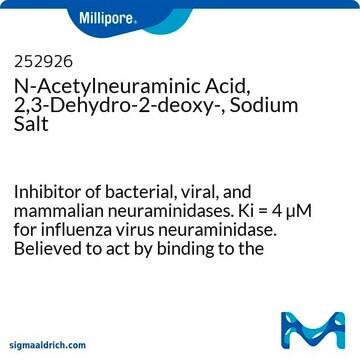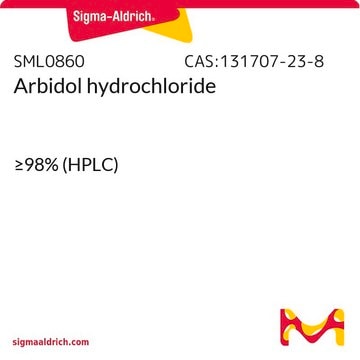SML0492
Zanamivir
≥98% (HPLC)
Synonym(s):
4-Guanidino-2,4-dideoxy-2,3-dehydro-N-acetylneuraminic acid, 4-Guanidino-Neu5Ac2en
About This Item
Recommended Products
Assay
≥98% (HPLC)
form
powder
optical activity
[α]/D +30 to +40°, c = 1 in H2O
color
white to beige
solubility
H2O: 10 mg/mL, clear
storage temp.
room temp
SMILES string
CC(=O)N[C@@H]1[C@@H](NC(N)=N)C=C(O[C@H]1[C@H](O)[C@H](O)CO)C(O)=O
InChI
1S/C12H20N4O7/c1-4(18)15-8-5(16-12(13)14)2-7(11(21)22)23-10(8)9(20)6(19)3-17/h2,5-6,8-10,17,19-20H,3H2,1H3,(H,15,18)(H,21,22)(H4,13,14,16)/t5-,6+,8+,9+,10+/m0/s1
InChI key
ARAIBEBZBOPLMB-UFGQHTETSA-N
Looking for similar products? Visit Product Comparison Guide
Application
- as a neuraminidase inhibitor to study its effects on influenza A virus (IAV) like particles
- as a neuraminidase inhibitor to study its effects on lipopolysaccharide (LPS)-mediated pathology in sepsis
- as an antiviral to study its effects on influenza B virus by plaque reduction assay
Biochem/physiol Actions
Signal Word
Warning
Hazard Statements
Precautionary Statements
Hazard Classifications
Acute Tox. 4 Oral - Eye Irrit. 2 - Skin Irrit. 2 - STOT SE 3
Target Organs
Respiratory system
Storage Class Code
11 - Combustible Solids
WGK
WGK 3
Flash Point(F)
Not applicable
Flash Point(C)
Not applicable
Certificates of Analysis (COA)
Search for Certificates of Analysis (COA) by entering the products Lot/Batch Number. Lot and Batch Numbers can be found on a product’s label following the words ‘Lot’ or ‘Batch’.
Already Own This Product?
Find documentation for the products that you have recently purchased in the Document Library.
Customers Also Viewed
Our team of scientists has experience in all areas of research including Life Science, Material Science, Chemical Synthesis, Chromatography, Analytical and many others.
Contact Technical Service












